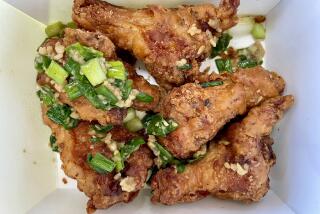RESTAURANTS : The Only Frills Are in the Fine Flavors
At first glance, Peking Restaurant gives the impression of a long, dark slit, like the viewer on an old-fashioned box camera. It’s hard by a martial arts studio and just a storefront away from the mammoth Cantonese restaurant Seafood Paradise.
The easiest way to categorize Peking is paradoxical--a no-frills deluxe noodle house. To anybody who craves Chinese handmade noodles and pot-sticker dumplings, Peking is the rainbow’s end. Even those who don’t will find it a solidly dependable Westminster spot for mostly authentic Chinese dishes.
Chef James Yang hails from Shandong province in northern China. He’s rarely in the dining room, but look through the dumbwaiter-size opening in the wall, halfway towardthe back. Yes, that’s him, toiling ceaselessly next to a grandmotherly assistant. Yang hardly courts fame. He doesn’t do interviews and hasn’t changed his English-language menu in more than 10 years.
Expect a line here at peak hours. Noon or night, you’ll find an ethnically mixed crowd of diners, virtually all feasting on noodles and dumplings at one of the uncomfortable red slabs Peking uses as tables.
“No frills” means the paper napkins are diner-size; the chopsticks come wrapped in cellophane, the cruets of condiments (vinegar, soy and chili sauce) are small. Tea is poured from worn metal pots into faded, occasionally chipped porcelain cups. The quality of the food makes these appointments more than adequate.
One Saturday, I saw a man lunching alone, reading a Chinese-language magazine and sipping tea from a plain white cup . . . while facing up to a whole plate of fried dumplings. He was one happy-looking guy. After finishing off a plate of Yang’s exquisitely browned dumplings, I probably provided much the same picture.
Peking serves pot stickers that most little Asian restaurants can only dream about--10 long, narrow, meat-filled gondolas to an order, the edges neatly crimped, the bottoms running together in a single sheet of golden-brown dough. The filling is a delicious minced pork mixture, lean enough to be elegant, fatty enough to spill juice when the dumpling is pierced. The dough is springy and pulls away from the teeth, stubbornly al dente like all great pasta.
Yang’s noodles, which come topped with a choice of meats, are fabulous too, as long as you read the menu carefully. Pay attention to the line at the bottom of the noodle section that reads, “Hand made noodle, add $1.” If you don’t specify, you don’t get.
This has to be the biggest dollar bargain since the Homestead Act. By comparison with Peking’s chewy noodles, close kin to fettuccine, packaged Chinese noodles taste like straw.
A few of my favorite dishes at Peking are not on the restaurant’s English-language menu--an inconvenience; it makes ordering them a chore. At least onion pancake and shrimp egg roll are two items from that Chinese-language menu whose English names the waitresses know. The first is a delightful grilled flat bread, multilayered and delicately laced with chopped scallions. The second is a sort of glorified egg roll with a nifty filling of bamboo shoot, celery and fresh shrimp.
Peking’s walls are draped with signs advertising various other dishes in Chinese, and the waitresses will do their best to describe what’s up there (if they have time).
One of them is ma la chi pen (sesame oil chicken with translucent bean flour noodles), and one reason chef Yang hasn’t put it up for grabs on the English menu is that the noodle has no English name. It’s a great dish, too: squeaky-fresh bits of shredded white meat, tinged a faint red from a good dose of sesame oil, sitting on slippery, almost transparent noodles.
And that’s just one of the great untranslated dishes. If you can, go to Peking with someone who can read or speak Chinese. You’ll eat as if you were in a local lunch spot in Taipei.
Mixing these wall dishes with the regular menu, you could start a meal with a combination of cold appetizers: peanuts boiled with star anise, jellied pork leg, five-spice beef cut into thin, grainy rounds, a darkly stained lu dan or preserved egg (very salty) and a spicy chilled cucumber salad featuring a stark, bracing contrast of sweet and spicy.
Next, sample a thick soup--say, the one called plain dumpling soup, a Chinese version of chicken and dumplings. The soup is on the starchy side but tasty, and there must be an entire head of cabbage melted into it.
The plain dumplings are just what they are supposed to be, hand-pulled bits of dough that come to life in a hot broth. These dumplings look rather like spaetzle, minus the egg binder.
You could follow the soup with a dish such as garlic chicken, where sliced chicken leg is cooked with plenty of fresh garlic, or perhaps yu shiang pork, a typical northern Chinese farmhouse dish of julienned pork stir-fried with bamboo shoots, mushrooms, carrots, onions and hot bean sauce.
*
In theory, you’d finish with a noodle or rice dish, perhaps noodles with beef and onion or combination fried rice. None of these dishes will test your sense of adventure, really, not even the ones the staff consider too Chinese to translate.
For the record, the menu lists a number of soup noodles, as well as soei chow , the lighter, less-interesting steamed dumplings.
These dumplings come a whopping 15 to an order, crowded, but not stuck together, on a lackluster white plate.
The skins are nearly as chewy as any of Peking’s other flour-based dishes, and the filling is tasty. But the steamed dumplings, reminiscent of pelmeni , kreplach and a number of other international dumpling acts, are badly upstaged by the pot stickers. Come to think of it, what wouldn’t be?
Peking Restaurant is inexpensive. Dumplings are $3.95. Cold dishes are $1.50 to $6. Soups are $3.25. Entrees are $5.20 to $9.50.
* PEKING RESTAURANT
* 8588 Westminster Ave., Westminster.
* (714) 893-3020.
* Open 11 a.m. to 9 p.m. Tuesday through Sunday; closed Monday.
* Visa and MasterCard accepted.
More to Read
Eat your way across L.A.
Get our weekly Tasting Notes newsletter for reviews, news and more.
You may occasionally receive promotional content from the Los Angeles Times.









